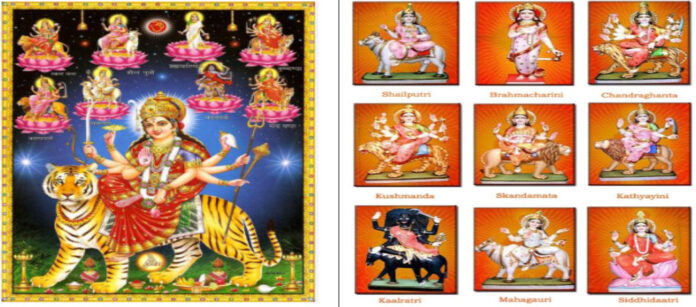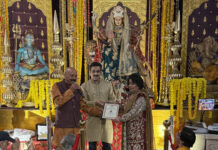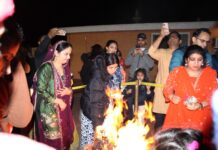Sunil Kumar D. and Geetha Patil
Durga Ashtami epitomizes the symbolic victory of righteousness over malevolence. According to ancient scriptures, it was on this day that the mighty Goddess Durga vanquished the demon Mahishasura, underlining the eternal triumph of divine forces over darkness and ignorance. According to the legend, this demon Mahishasura had a boon bestowed upon it by Lord Brahma that a female warrior could only defeat him. Goddess Durga slayed him at the end and her Nava Durga avatar symbolizes her enormous strength and valor.
Apparently, Masik Ashtami is also a sacred day and has deep spiritual significance for Sanatanis devoted to Goddess Durga. The Ashtami day of Navratri festival falls on the powerful Tithi of Shukla Paksha, and devotees come together in reverence, observing strict fasting and offering heartfelt prayers to the Goddess. Sanatanis celebrate the nine days long festival with pomp and show as well as with devotion to propitiate Ma Durga all over the world. This year, Ashtami falls on Thursday, October 10, 2024, starting 12:32 pm onwards and will end on October 11 at 12:07 pm.
Why Durga Ashtami is so significant and is highly venerated during Navratri?
During Navratri, many Sanatanis observe fasting and recite Durga Saptasati for all nine days to please Ma Durga. For the reason that SHE appeared as an answer to the prayers of gods and humans to kill the demons. Navaratri Ashtami is also known as Virashtami/Astra Puja day because all weapons are propitiated and worshipped on this day along with a display of martial arts. When Ma Durga prepared for the war and decided to annihilate the demon Mahishasura, the buffalo faced giant. In the meantime, all Gods wanted to give her their divine weapons and powers. All those weapons were worshipped before handing them over to Ma Durga on the day of Ashtami and therefore the day came to be called as Astra Puja day. Another name Virashtami attributed to this day heralds the courage and valor of Ma Durga and on the day of Ashtami, Ma Kali emerged from the face of Durga.
In addition, it is believed that the Astanayikas or the eight aspects of Durga that are emerged from her assumed their roles in the war. Therefore, on the day of Ashtami, the war with Mahishasura gained full momentum and force. There was also a fierce battle between Kali and demons Chanda, Munda, and Raktabhija. As part of the Navratri Puja, Ashtami is so significant for worshipping the 64 Yoginis, Ma Kali, Ma Durga, and the Ashtanayikas. These Ashtanayikas names include Brahmacharini, Maheshwari, Kameshwart, Vaishnava, Varahi, Narasinghi, Indrani, and Ma Chamunda. Each of these aspects signifies a particular attribute of Ma Durga.
The special Puja done on the day of Navratri Ashtami is meant to appease all the aspects of Ma Durga together and therefore it is highly significant. It is also believed that Ma Durga manifests on the Ashtami day of each month and special Pujas are performed to Ma Durga on Ashtami days. The Ashtami falling during Navratri festival is called Maha Ashtami or Maha Durga Ashtami
Ashtami is also second day of the last set of three days of Navratri dedicated to worshipping Ma Durga. On Maha Durga Ashtami, Ma Durga is pacified with an elaborate Puja. Ashtami and Navami are auspicious days to celebrate the essence of womanhood. Therefore, on this day, Sanatanis observe Kanya Pujan across India and all over the world. Kanya Puja on Ashtami or Navami is offered to Ma Shakti. Usually nine girls who have not attained puberty are invited to homes and their feet are washed .They are considered to represent the nine forms of Ma Durga namely Shailaputri, Brahmacharini, Chandraghanta, Kushmanda, Skandamata, Katyayani, Kalaratri, Maha Gauri and Siddhidhatri. Girls are presented with delicious food and some nice gifts, which are believed to pacify Ma Durga.
It is believed that on Ashtami, the eight incarnation of Ma Durga/Maha Gauri took birth for the welfare of her devotees. She is the problem solver and bestows good health, good life, and happiness to all. The most famous Sandhi Puja connected with Navratri is observed on Ashtami. This is the time when the Ashtami Tithi ends and Navami Tithi starts. At this time, a symbolic Balidan or sacrifice consisting of cutting pumpkins is done on this day and is offered to Ma Durga since animal sacrifice is prohibited in Bharat.
Navaratri festival that involves the ceremonial worship of Goddess Durga in nine forms spread over nine nights and celebrated in different ways across various parts of Bharat. Durga Ashtami is celebrated with great passion and fervor especially in West Bengal where the ten-armed Goddess riding loin is highly regarded and even her weapons, which symbolize the masculine strength are worshipped while reciting mantras in a ritual known as Astra Puja. Massive idols of Goddess Durga are installed throughout India, in enormous Puja Pandals that are set up at various places for devotees to visit and worship Goddess Durga. Durga Ashtami celebrates the victory of Goddess Durga over the evil buffalo demon Mahishasura.
During Navaratri, women tend to take center stage that reminds us how women used to hold more power and status in ancient Baharat, especially in West Bengal, Odessa, and Assam. In South Bharat, vehicles, books, computers, and tools are worshipped on the ninth day as an expression of gratitude for the blessings received in the previous year. By offering the tools of their trade to Goddess, people commit to performing all work as worship.
Sanatani widely celebrate Navaratri to receive blessings of Goddess Durga with the hope of being granted wealth, prosperity, as well as knowledge. Every festival in Bharat is associated with wealth and encourages people to make investments in the form of gold, silver or other kinds of properties. People strongly tend to believe that investing in some special endeavor or starting something new trade on such auspicious occasions will bring in more happiness and prosperity in the following years. Thus, Durga Ashtami is most significant for the Sanatana Dharma and Sanatanis celebrate it with great devotion and fervor.
Also Read: Tripura CM Manik Saha inaugurates 10 Durga Puja pandals in Agartala







